Nyiur melambai di tepi pantai ǀ Palm leaves waving on the beach
Menghias indah wajah tanah airku ǀ Adorning the beautiful face of my homeland
Siulan burung di puncak bambu ǀ Birds singing on top of bambo trees
Berirama pujaan tumpah darahku ǀ Rhyming with the adoration of my motherland
Sawah ladang luas ǀ Vast rice paddies and fields
Lenggang padi kuning berayun ǀ Yellow rice plants swaying around
Memanggil semua bertamasya ǀ Calling everyone to go on vacation
Memuja alam Indonesia ǀ Admiring the nature of Indonesia
Sungguh indah pandangan tanah airku ǀ How beautiful the landscapes of my homeland are
– Tamasya by Daljono, a song often sung in Indonesian children singing competition
Most Indonesian children are familiarized with songs about the beauty of their country since early childhood, usually describing the lush, fertile and incomparable Indonesian natural landscapes. Give them a piece of paper and crayons or colored pencils, then ask them to draw anything related to landscape. More than 90% would end up drawing mountains – usually two – with the sun peeking out from the slopes in between, a road going towards the valley overshadowed by the peaks, and a small house on one side of the road with rice paddies on the other side.
The mountains illustration – usually cone-shaped – might be inspired from the abundance of volcanoes across Indonesia, one of the most volcanically active countries in the notorious Pacific Ring of Fire. Of all Indonesian major islands, only Borneo and New Guinea lack volcanoes on their soils. They take lives, but from the ashes they spew grow multitude of tropical richness, eventually providing livelihood for the widely agrarian society.
From which grows rice, the staple for most Indonesians, with the exception of the people in Maluku and Papua who rely on sago – known as sagu to locals. So important rice is for Indonesians we have different names to call it, depending on its life stage: padi for unharvested rice, gabah for harvested rice, beras for cleaned rice seeds, and finally nasi for cooked rice.
In Bali, a mountainous and fertile tropical island in the archipelago, rice is as important in people’s lives as in other parts of Indonesia. In a society where agriculture remains the main subsistence despite the thriving tourism industry, well-cultivated land is crucial to ensure the rice production continuity on the island. However with a total area of less than 6,000 square km and its location within the tropics rice production on the island is very much dependent on the cycle of rainy and dry seasons. Normally farmers would start planting at the beginning of rainy season to ensure their rice paddies well-irrigated, but in Bali that is not always the case.
When James and I was in Yeh Pulu a farmer was spreading fertilizers; around Ubud paddies were all in fresh green color, starting their journey to maturity; in Jatiluwih – Bali’s most majestic rice terraces – the rice had started to turn yellow, a captivating sight amid the island’s prolific green tapestry; meanwhile near Candi Gunung Kawi local farmers had already started harvesting their rice.
The ingenious Balinese people created Subak system which not only provides irrigation to rice paddies, but also regulates the wider cultural landscape in Balinese society, which in turn enables continuous rice cultivation regardless the season. Subak’s principle in adherence to Tri Hita Karana – Balinese way of seeking harmony with gods, people and nature – means active involvement from villagers, supervised by Hindu priests, to manage weirs and canals for the benefit of all. All these efforts to preserve Balinese cultural landscape, including Subak system, resulted in its enlistment as a UNESCO World Heritage Site in 2012, Indonesia’s eighth and latest.
“Jatiluwih means very beautiful,” Bli Komang told us. “The water here is so clear that people bathe in it,” he continued while pointing his finger at a canal.
“To preserve land’s fertility, farmers in Bali usually plant rice twice a year and something else after the second harvest season is over and before another cycle starts,” he recounted. “It can be long bean, soybean, or anything.”
A thin wisp of smoke rose from a small hut in the middle of the terraces. “It smells nice. What is it?” James was curious.
“It’s burned cow dung,” Bli Komang said and smiled. “They use it as fertilizer.”
As far as my eyes could see in every harvested rice paddy, a small patch of land remained untouched. “They always leave a patch of the rice paddy, roughly 50×50 square cm, for Dewi Sri, the rice goddess,” Bli Komang explained how the pre-Hindu Javanese-Balinese deity is still revered on the island.
Despite their ingenuity in irrigation system, Balinese are still deeply religious people, keen to always live with Tri Hita Karana principles, reflected from the small and colorful offerings of canang sari to the management of Subak system.
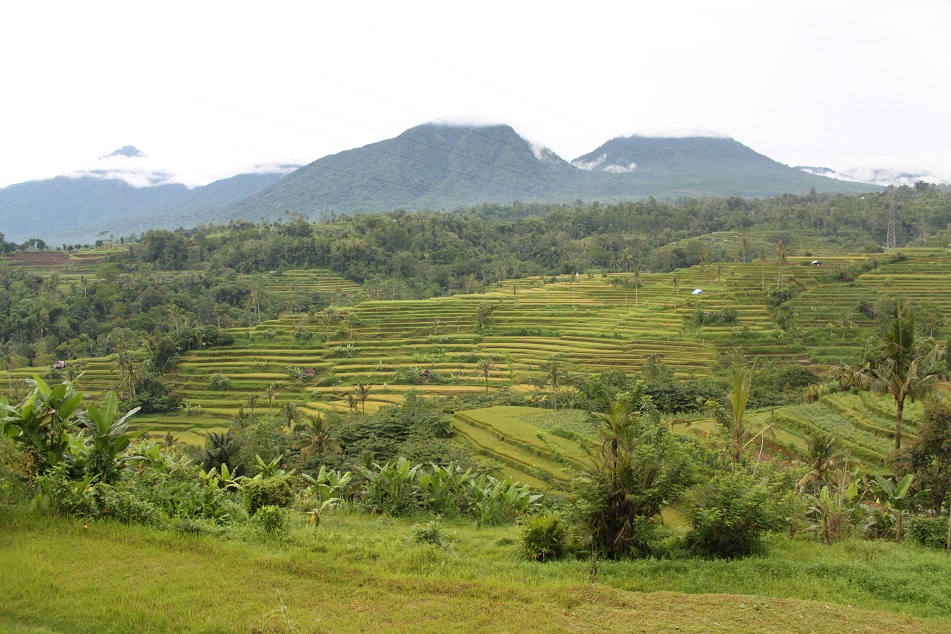
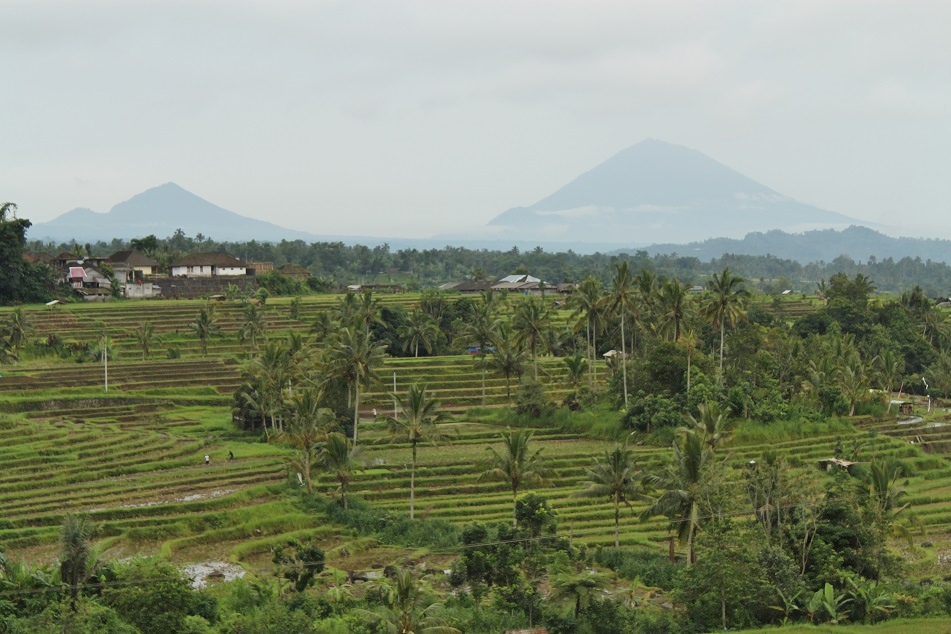
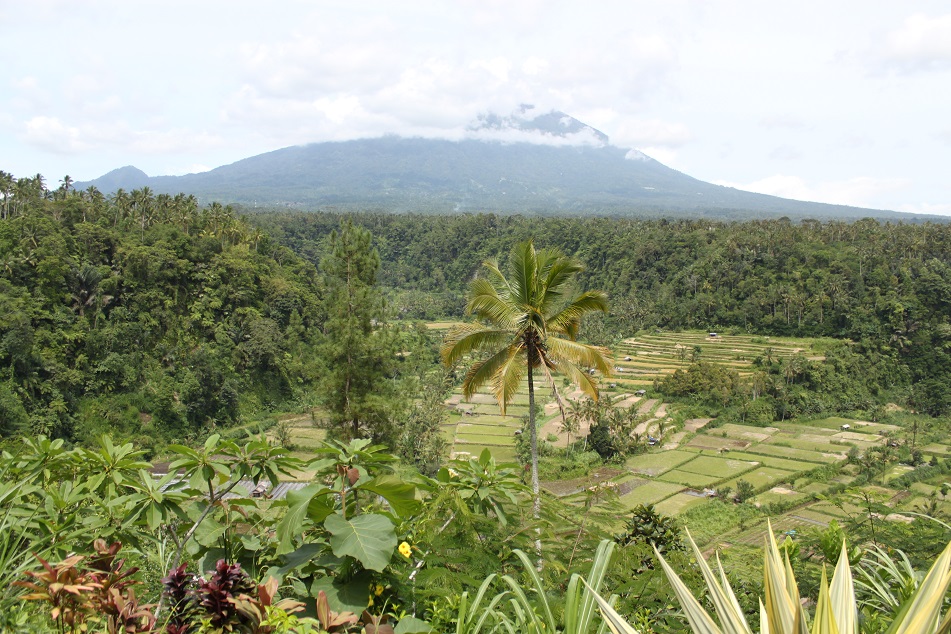
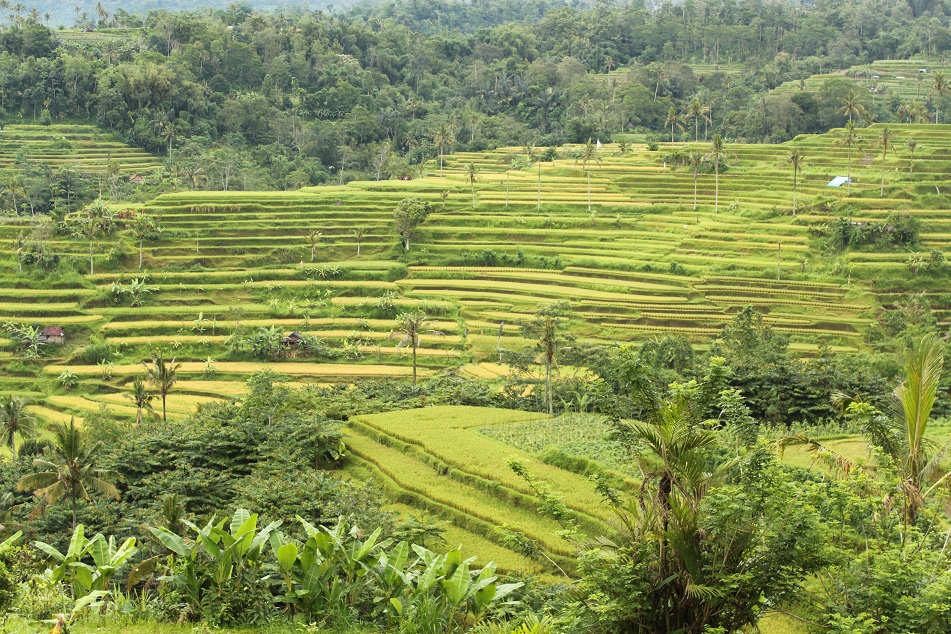
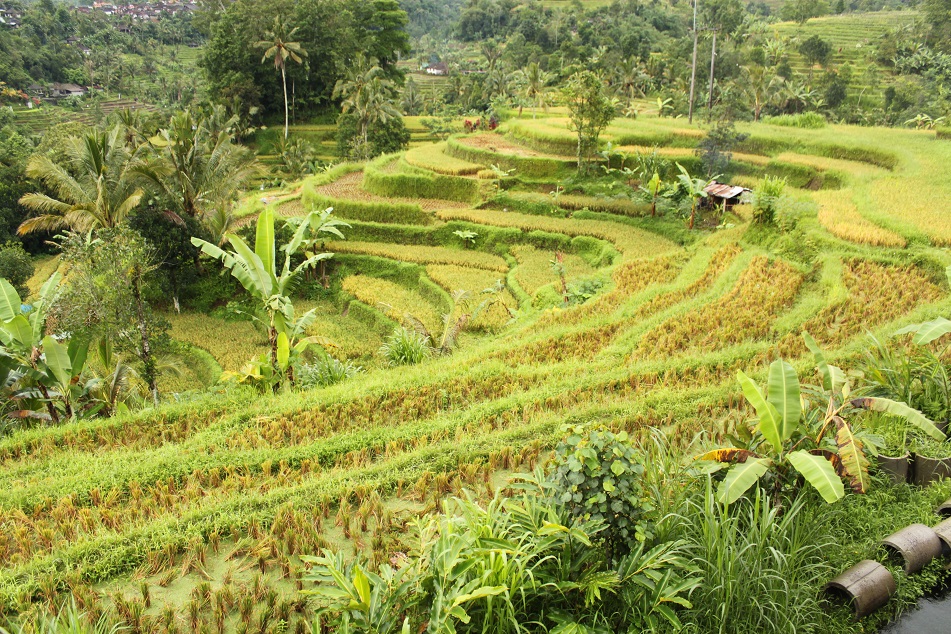
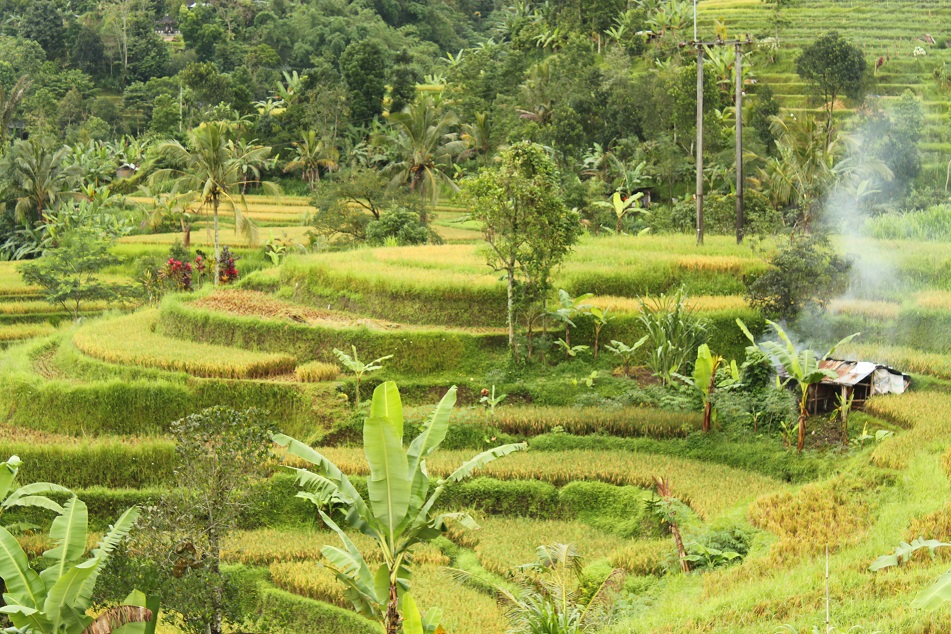
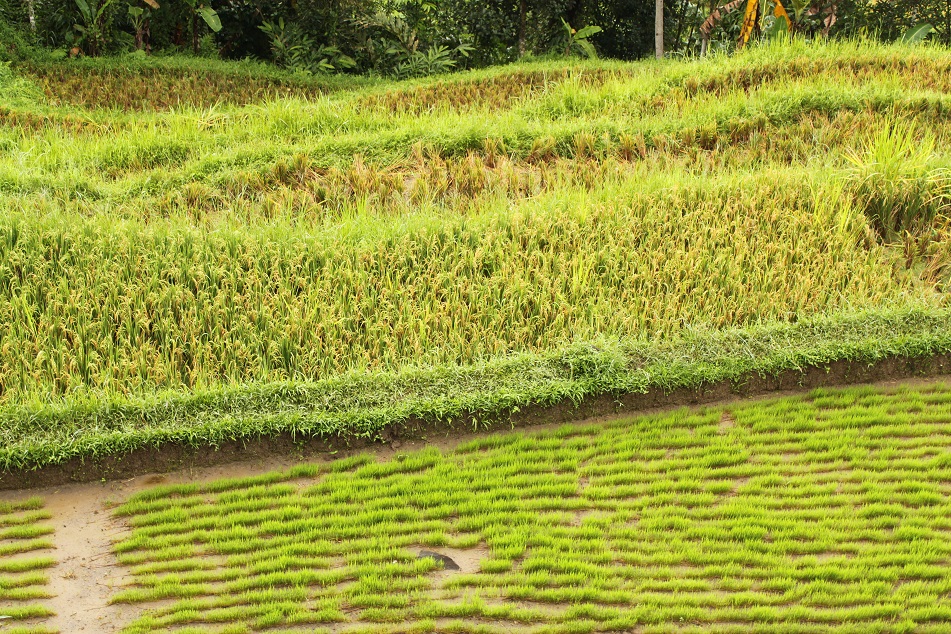
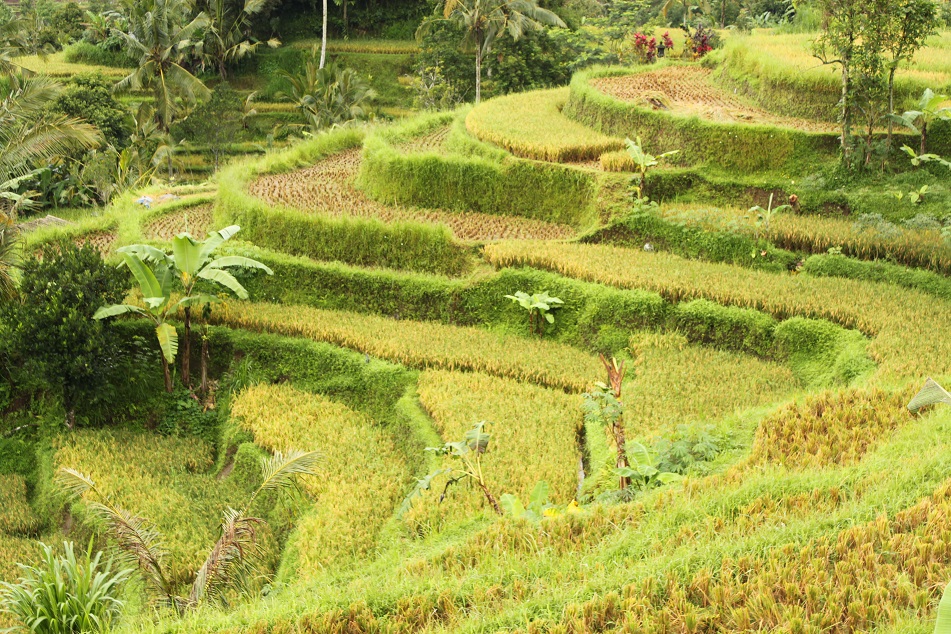
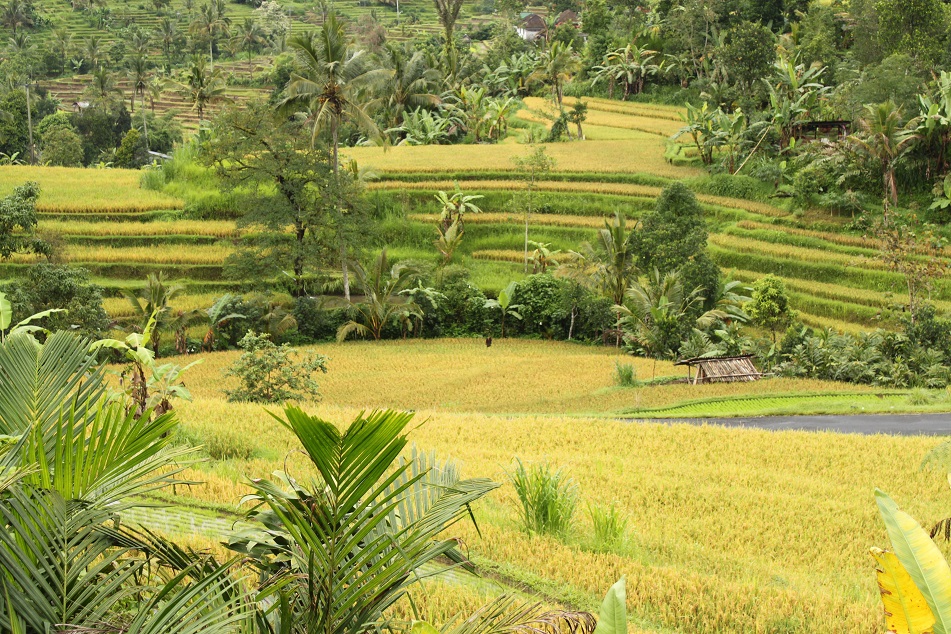
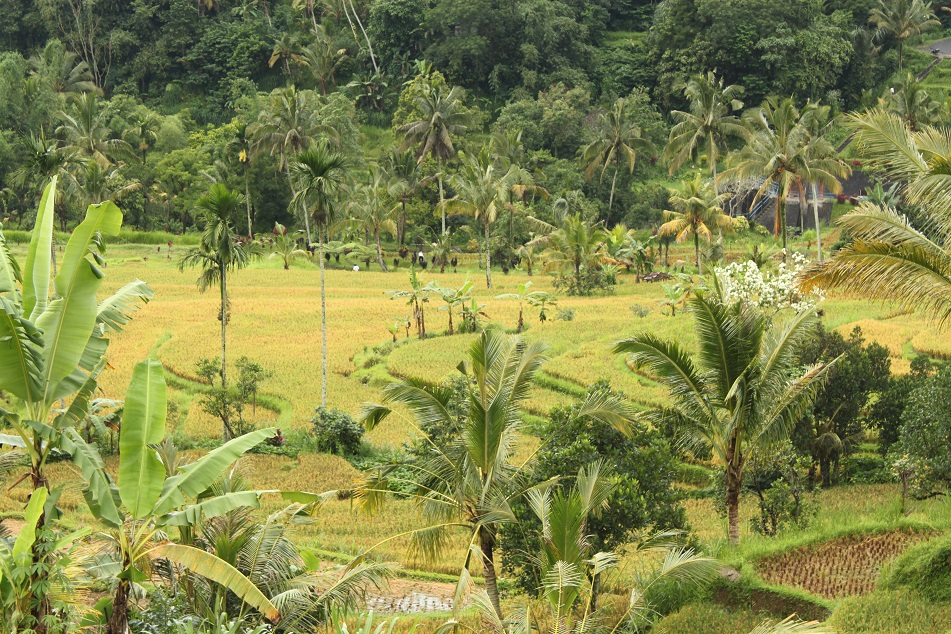
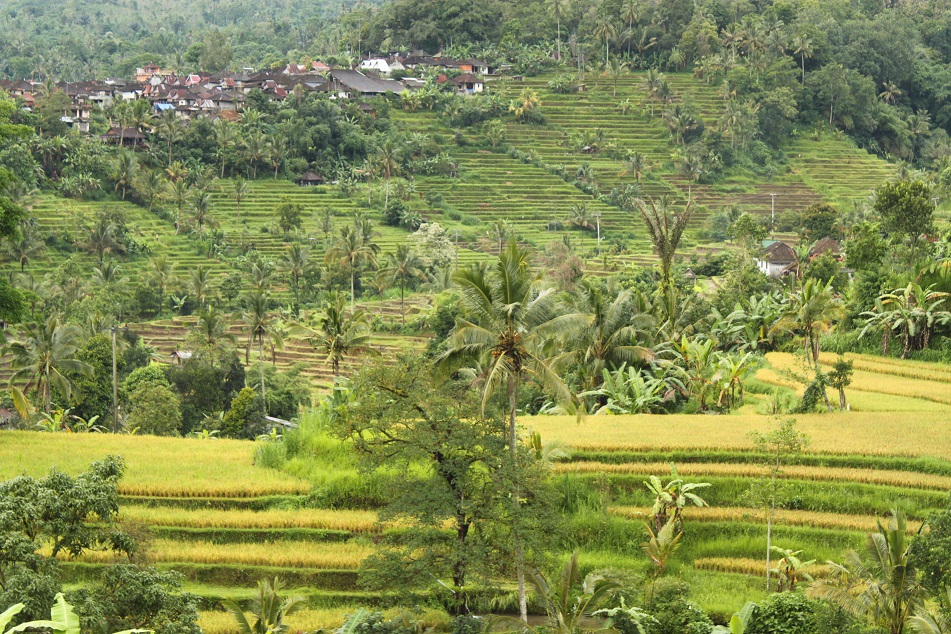
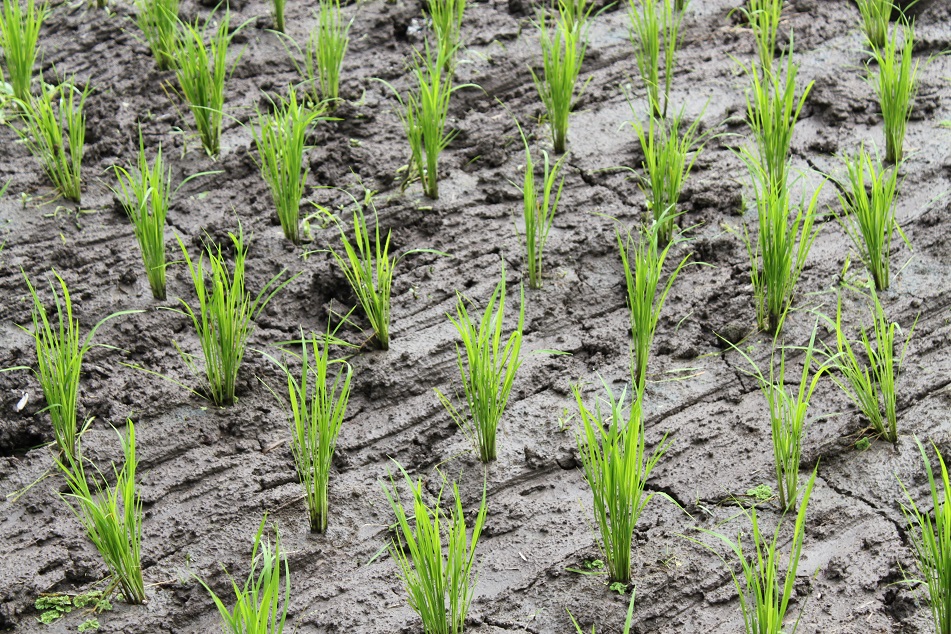
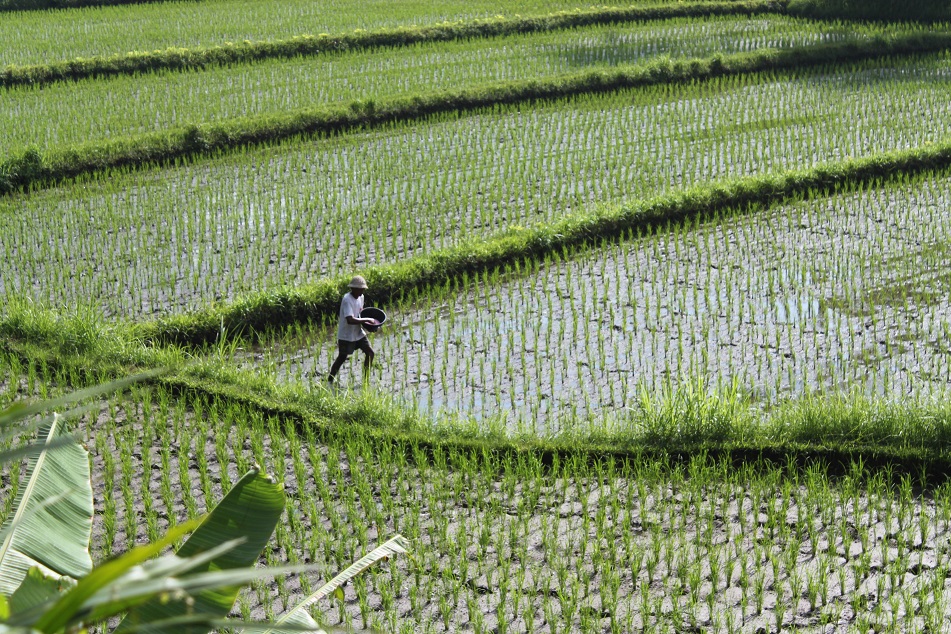
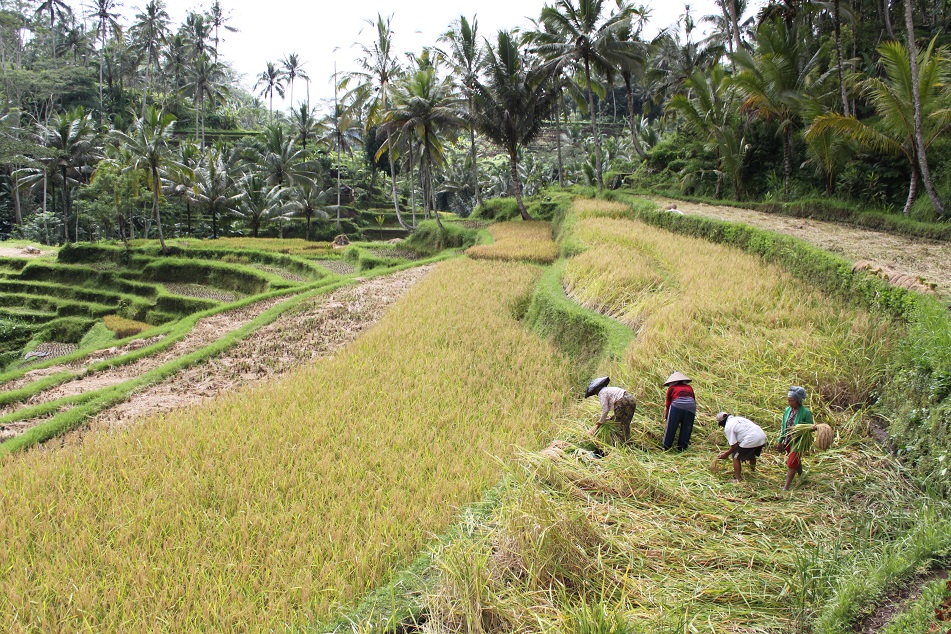
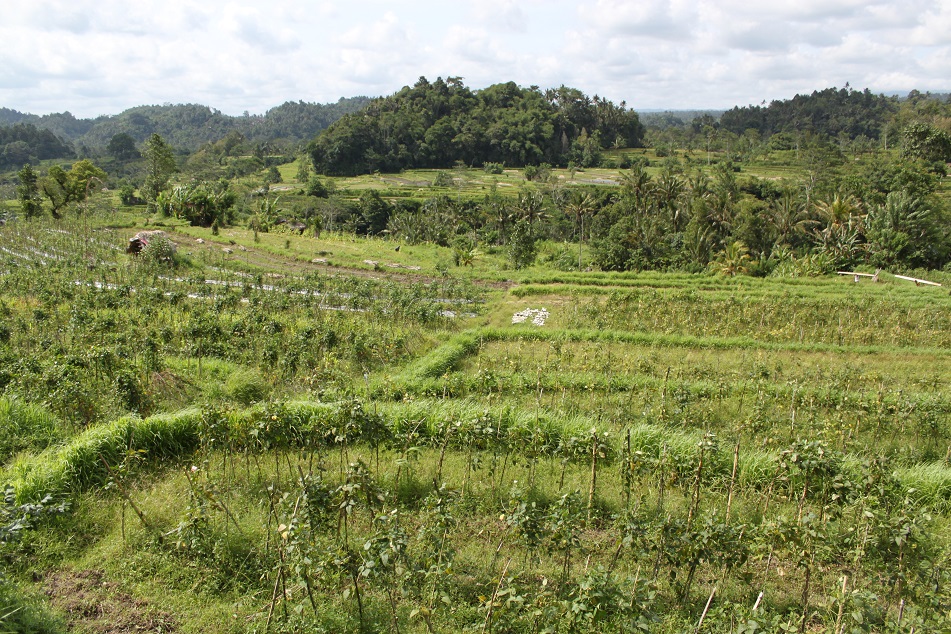
Beautiful pictures and a well told story!
LikeLiked by 1 person
Thank you, Shikha. Bali’s rice terraces just blew my mind away!
LikeLike
I enjoyed this very much Bama. your wonderful gallery and descriptive prose brought back memories of the days when we had paddy swaying outside our kitchen window! I really miss these scenes when I visit my hometown these days.
LikeLiked by 1 person
Thanks Madhu! It’s sad that those scenic views are disappearing fast in many parts of the world. Fortunately some local communities are striving to preserve their centuries-old traditions, like what Balinese do to their unique irrigation system, ensuring those rice paddies to thrive.
LikeLike
Bama, I too was stunned by the sheer beauty of Bali’s rice terraces – they were even better in person! I do wonder how Jatiluwih would have looked if it was sunny that day… it gives us another reason to return to the ‘Island of the Gods’. I didn’t know whether to laugh at the burning cow dung, it honestly smelled wonderful!
LikeLiked by 1 person
I’m really glad we went to different areas in Bali to witness ourselves how Subak enabled the Balinese to cultivate rice paddies all year long. I’ve seen rice paddies elsewhere, but Jatiluwih is very special, indeed. There are so many reasons to come back to Bali, and we keep discovering them, one reason at a time. 🙂 Had Bli Komang not told me that it was actually burned cow dung, I would have thought the same with you I believe.
LikeLike
My friend and I had once discussed about the difference between the urban people and the villagers in the journey of acknowledging God(s). For urban people God(s) is mostly acknowledged through texts and lectures (rigid, fragile, not enough time and space for contemplation). Meanwhile the villagers acknowledge the presence of God(s) through the nature in a very reflective way, often expressed in metaphors. We think that the latter approach stains deeper and well manifested in form of harmony :’)
LikeLike
I can see the point as we are far more inspired by nature than by skyscrapers, aren’t we? I just can’t imagine if more and more natural landscapes are turned into man-made structures made from concrete.
LikeLike
It seems like Hurdes (Extremadura, España).
LikeLike
I’ve never heard of Hurdes before, but from the photos that I googled I can see why the pictures in this post remind you of that area.
LikeLike
Yes, I know there’s no relationship between the climatology or the vegetation in both areas, but, when I saw the first photo, I remember the “terrazas” over the river bank, typical from Las Hurdes…
LikeLike
This is an exceptionally beautiful story beginning with a lovely song and continuing on through your descriptions and superb photos. The graceful curving lines of the fields and their many shades of green are just stunning. I think my favorite is “Preparing Organic Fertilizers” – the composition and the smoke showing activity at the little building.
LikeLike
Thank you, Marilyn! It’s hard to be inspired by the sheer beauty of Balinese rice terraces. Looking at my own photos reminded me of that song which I happened to sing when I was little. 🙂 The timing couldn’t be more perfect either, especially at Jatiluwih where the rice paddies were in golden galore.
LikeLike
Beautiful photos and another eloquent post. The photo of the young rice plants really caught my eye.
LikeLike
Thanks Sue! I can imagine you cycling around the rice terraces at Jatiluwih and enjoying the amazing vista. 🙂
LikeLike
Oh that sounds fantastic! Do you know if there are guided cycling tours in the area?
LikeLike
I’m not sure about guided cycling tours, but I’m sure some hotels can help you with that. However I guess it’s more common for people to cycle independently on the island.
LikeLike
Thanks Bama. We will definitely keep it in mind. Looks amazing.
LikeLike
Beautiful, the terrace farming of SE Asia is art and I love the dialogue you create with your words and photos. Cheers.
LikeLike
Thanks Randall! Sometimes I forget the beauty in my own backyard, but the visit to those Balinese rice terraces reminded me of that again.
LikeLike
Reblogged this on Voices and Visions.
LikeLike
Talk about perfect planning, Bama – in all my trips I’ve never experienced a perfect crossover of seasons like this – just wonderful 🙂
LikeLike
We couldn’t have been luckier, Meredith. We went to Bali during rainy season, yet we experienced all the contrasts of Balinese scenic rice terraces.
LikeLike
As I said – perfect planning – and huge doses of luck!
LikeLike
Awww!!!! Rindu sekali! Great series of images …..looking forward to being there again pd bulan septembre……trims lagi Trees
LikeLike
Terima kasih! Semoga liburan ke Bali bulan September nanti benar-benar menyenangkan! 🙂
LikeLike
Reblogged this on When I'm Not On My Job and commented:
Hikmah di balik semua kejadian, manfaat dari sebuah keadaan, cantik sekali negeri ini! mudah-mudahan pengelola baru negeri ini mewujudkan tatanan kehidupan & Penghidupan seluruh masyarakatnya menjadi lebih baik, dibalik banyak hal yang tidak mungkin tidak menguntungkan! sungguh beruntung sekali kita lahir disini, di negeri ini! Indonesia.
LikeLike
Love the photos, the scenery looks so lush and green. Can’t imagine burning cow dung to be a pleasant smell though!
LikeLike
Thank you, Emma! I was surprised as well. Never thought burned cow dung would be so… fragrant. 🙂
LikeLike
There is something about “terrace farming” which looks great in images and when you are in the middle of it you feel even better.
I felt it in India and your images are really top class, Bama 🙂
LikeLike
Absolutely! Rice terraces are probably one of the best, most beneficial and most beautiful inventions ever. Thanks a lot, Sreejith! By the way, which part of India did the photos remind you of?
LikeLike
You could find terrace farming in my native Kerala and the neighboring state of Karnataka.
The slope of hills here are relatively less and the views won’t be as dramatic as that in Indonesia and Vietnam and all.
LikeLike
Ahh, I see. I was thinking of Kerala as well but I was not sure. I’m very intrigued by the pictures of the highlands forming the border between Kerala and Tamil Nadu. So many places to go in your country! 🙂
LikeLike
Yes Bama, that’s exactly the area.
Looks like you already have done a lot of back ground research and just needed to plan a trip to India 🙂
LikeLike
Reblogged this on TAKE A DEEP BREATH and commented:
In questa sta spendida giornata di sole che voglia di natura !!!
LikeLike
magnificent photos! try visiting Phils too…
http://travelthewriteway.wordpress.com/
LikeLike
Thank you! I’ve been eyeing some places in the Philippines for quite some time now. Albay, Bohol and the rice terraces at Banaue are some of them.
LikeLike
all the places you’ve said are beautiful… don’t forget to include Coron, Palaawan and Pangasinan! 🙂
LikeLike
Beautiful. I can’t stop staring at your photos. I love rice terraces. Their beauty and amazing design always fascinate me. Interesting to learn about Subak system. The locals love for their nature certainly manifests in the healthy abundance of these terraces.
LikeLike
I would go to those rice terraces again in a heartbeat the next time I visit Bali. Such a beautiful embodiment of Bali’s agrarian culture, indeed. However one day I would love to visit Luzon’s Banaue rice terraces. 🙂
LikeLike
I have nominated you for the Leibster Award! The Liebster Award is a blogger award given by bloggers to bloggers in order to broaden the blogging community. Check out my post here for more details.
http://militarywifememoir.wordpress.com/2014/03/09/liebster-award/
LikeLike
Thank you for the nomination, Ellie!
LikeLike
This is such a beautiful way of gardening, lovely photography.
http://livinginthefreeworld.com
LikeLike
Never thought of rice terracing as gardening, but it is analogous indeed. Thank you, Shane!
LikeLike
It goes to show humankind and nature can work beautifully together.
LikeLike
Indeed. We need to learn more about local wisdom like this and implement it in our daily lives.
LikeLike
I love how you’ve incorporated the song 🙂 great piece of writing, I will definitely start to follow you. Perhaps you’d like my writings about Bali…
LikeLike
Thank you, Debbie! I just took a quick look at your blog and apparently you’ve been to Trunyan, one of the places in Bali that I have yet to visit. Interesting!
LikeLike
Your photos are stunning! It’s so sad that so many people go to Bali and have no idea that they can see this sort of thing… hopefully the efforts to preserve and protect it all continue : )
LikeLike
Thank you, Jess! Unfortunately many people who go to Bali are not necessarily aware of what the island has to offer. They just stick to the overly touristy southern Bali and leave the island without knowing its rich cultural sights.
LikeLike
Gorgeous photos, thanks for sharing! I am visiting Bali in September and am very excited to read posts about it.
LikeLike
Thank you! I will still be writing more posts on Bali for the next few months. My last trip to the island in December was exceptionally rich with experiences and stories. Hope you have a nice stay in Bali later this year!
LikeLike
amazing photos and I´m planning to go as soon as possible. loved this post 🙂
LikeLike
Thank you, Nina! Hopefully you’ll make it to Bali sooner than later! 🙂
LikeLike
amazing and beautiful nature. Visit my Blog! 🙂
LikeLike
Pingback: The Jewel of Eastern Bali | What an Amazing World!
Stunning photos… Awesome! I’ve just visited Bali in March, i wish i could enjoy the beach more but the time frame too short. Anyway i’ve been to Ubud and see myself the beauty of the terrace rice field, seriously stunning…
LikeLike
Thank you, Achika. If you come back to Indonesia and seriously consider visiting some beaches, I recommend Lombok. Its southern beaches are by far some of the best I’ve ever seen in my life. While for Bali itself, Ubud is always a good place to start your exploration of the island.
LikeLike
very beautiful photos. i should have been there last March, had the mishap of MAS not happen.
LikeLike
Oh dear. Well, Bali will always be there, but I suggest you to avoid coming to the island during Indonesian school holiday, which is around this time of the year. I’m in Bali now and it’s anything like what I saw last December.
LikeLike
Really? Well, thank you for the heads up! 🙂
LikeLike
You’re welcome!
LikeLike
Pingback: The Tale of Two Temples | What an Amazing World!
Amazing pictures! Never been to Indonesia, it’s time to change that 🙂 Regards from the Czech Republic.
LikeLike
Hi Teresa. Thank you very much! Likewise here — Czech Republic is one of the countries I want to visit the most in Europe. I love culture, history and architecture, so I know Czech Republic is the right place to go. 🙂 I hope you’ll make it to Indonesia sooner than later.
LikeLike
Since I spent a couple of years abroad I find it a little bit hard to fall in love with my country again. But one thing I’m sure of – Prague is one of the most beautiful places in the whole world. You will love this city. 🙂
LikeLike
Well, no country is perfect. But yes, the more I see images of Prague, the more I want to visit the city right away! Everything looks so photogenic.
LikeLike
Reblogged this on maverickbird.
LikeLike
Jatiluwih!
LikeLike
Pingback: The Dutch, the Caretaker, and the Little Girl | What an Amazing World!